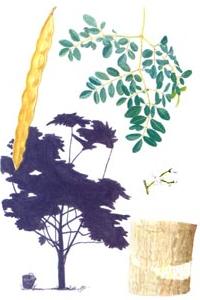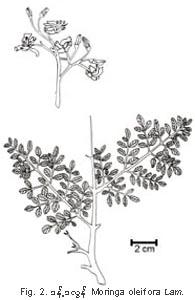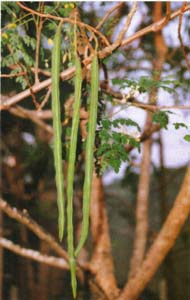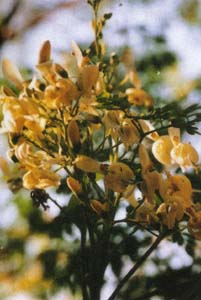Moringa oleifera {dan.tha-lun}
compiled by U Kyaw Tun, U Pe Than, and staff of TIL. Not for sale.
Family: Moringaceae 1
entry
Moringa oleifera {dan.tha-lun}
; {dan.da.lun}
Main Index of DB | Top
Contents of this page


Syn. : Moringa pterygosperma, M. moringa
Burmese-Myanmar transcript names:
Agri.Dept.2000 32-0827:
{dan.tha.lwun}
FAO 157: dan-da-lun
Lè-seik-shin 223:
{dan.tha.lwun}
KS-TMN 162: Dant-da-lun; Dant-tha-lun
Nagathein 2-087:
{dan.tha.lwun
(a.cho)}
UHM 33: Dan-da-lon
Myanmar-Script Spelling :
Official Myanmar Dictionaries:
{dan.tha.lwun} -
--TravPo-M-Dict
155
{dan.tha.lwun} - n. horseradish tree. Moringa oleifera. -- Myan-Engl-Dict
215
Hindi:


Sanskrit:
English common name used in Myanmar :
Agri.Dept.2000 32-0827: Drumstick tree
FAO 157: Horse raddish tree, drumstick tree, ben oil tree
Lè-seik-shin 223 : Horse radish
KS-TMN 162: Drumstick Tree; Indian Horse-radish
Nagathein 2-087: NG
UHM 33: Drumstick tree
Picture:
Leader: left - MB-SG; right - FAO
Photos: left -- habit with flowers;
right -- habit with fruits. Click on the pictures to enlarge. -- KS-TMN
Plant identification characters :
Key characteristics: Shrub or small tree; umbrella-shaped crown; bark corky or gummy; deciduous; oddly bi- or tri-pinnate leaves 2070 cm long; leaflets ovate, 12 cm long, whitish below; seed pods 1545 cm long, with 9 ribs and 3 valves; white fragrant flowers. Description: A fast growing deciduous shrub or small tree up to 12 m tall and 30 cm in diameter with an umbrella-shaped open crown (unless repeatedly coppiced). The bark is corky and gummy. Leaves are alternate, oddly bi- or tri-pinnately compound, triangular in outline and 20 70 cm long. Each pinnae has 39 pairs of 12 cm long ovate leaflets, soft dark green above and whitish below. The white, fragrant flowers are in pendulous panicles 1.52 cm long from leaf corners. The fruit pods are 1545 cm long, 9-ribbed capsules opening by three valves to release the 3-winged seeds. -- FAO
A small or middle-sized tree, deciduous; bark gray, corky, wood soft, spongy, the younger stems terete, tomentose. Leaves alternate, usually tripinnately compound, imparipinnate; exstipulate; petioles cylindrical, pulvinate; petiolules slender, pinnae and pinnules opposite, the pinnules (leaflets) 6-9 pairs, the terminal leaflet obovate, slightly larger than the lateral ones, the lateral leaflets elliptic to oblong, the bases oblique, the margins entire, the tips retuse, the upper surfaces puberulous, the lower glabrous; stipels as minute glands at articulations. Inflorescences axillary paniculate cymes; peduncles glabrous; bracts linear, minute. Flowers ebracteolate, pedicellate, bisexual, zygomorphic, cymes; pentamerous, hypogynous. Perianth apophyllous, 2-seriate, sepals 5, elliptic, reflexed, unequal, borne on the rim of the hypanthium, tomentose; petals 5, inserted on the rim of hypanthium, the anterior petal elliptic, larger, erect, the other petals spathulate with curved claws, reflexed, white to yellowish white, papillose, hypanthium cup-shaped. Androecium polyandrous, stamens borne on the disc rim, the inner whorl of 5 fertile stamens alternating with an outer whorl of 5 staminodes, the filaments unequal in length, the bases dilated, tomentose, the anthers monothecous, oblongoid, dorsifixed, dehiscence longitudinal. Pistil 1, ovary ellipsoid, 3-carpelled, syncarpous, 1-loculed, stipitate, curved, villous, the ovules numerous, in 2 rows on each of 3 parietal placentae, pendulous, the style 1, slender, the stigma truncate. Fruit a silique-like capsule, elongated, triquetrous, 3-valved, 9-ribbed; seeds globose, many, 3-winged, non-endospermic. Flowering period: November-January. Fruiting period: December-February -- KS-TMN
A small or medium-sized tree, bark corky, wood soft, young parts tomentose, leaves 30-60cm., usually 3-pinnate, flowers white, honey-scented, fruit a pendulous 9-ribbed pod. -- UHM
Distribution in Myanmar:
Planted -- KS-TMN
Cultivated elsewhere throughout Burma. -- UHM
Distribution elsewhere:
Originates in India and Arabia but is now naturalized throughout the tropics. Not reported from Cambodia. Ecology: Tropical pioneer species along watercourses, ponds and lakes, up to 750 m altitude, in areas with annual rainfall of 7502,250 mm. Adaptable to soil conditions but does not tolerate waterlogging. -- FAO
Part used and used as:
Although the wood is soft, it is often used for firewood. The leaves are commonly eaten as a vegetable or used as livestock fodder. Flowers are cooked in soups. Pods are edible when young and oil is extracted from the seeds. The root can be eaten as a substitute for horse raddish. Also produces good quality honey. Roots, bark, leaves and oil are used in traditional medicine. -- FAO
Bark and leaf decoction -- Analgesic for severe pains. Bark of root -- Expectorant; Analgesic; Antiseptic; Aphrodisiac; Promotes peristalsis of the intestine; Oedema; Indigestion; Emphysema of the lungs; Heart disease; Eye disease; Otalgia; Lipoma; Heals boils and carbuncles. Leaf -- Analgesic; Alcohol intoxication; Confusion; Hiccough; Asthma; Eye disease; Biliousness. Flower -- Oedema; Ascites; Cancer; As an expectorant and carminative. Seed -- Head-ache; Antidote for poisons; Eye disease. Seed-oil -- Pruritis; Heals boils and carbuncles. -- KS-TMN
Used as intermittent fever, epilepsy, hysteria, palsy, chronic rheumatism, dropsy, enlargement of the spleen and dyspepsia. -- UHM
Constituents:
Alkaloids: moringine and moringinine (30) -- UHM
Main
Index of DB | Top
Contents of this page
Entry format: Botanical name / Family / Ref. Burmese-Myanmar
transcripts ( Agri.Dept.2000 :
FAO :
Lè-seik-shin :
KS-TMN:
Nagathein :
UHM :/ Myanmar-Script Spelling (
Official Myanmar Dictionaries : - TravPo-M-Dict - Myan-Engl-Dict - Myan-Ortho
/ Hindi /
Sanskrit / English common name used in Myanmar / Picture /
Plant identification characters / Distribution in Myanmar / Part
used and uses / Constituents /
End of TIL file